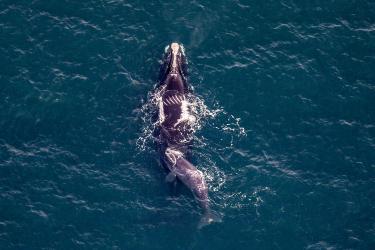He and his collaborators are tagging them with special pop-off satellite and acoustic tags to better understand their movements and migration behaviors. While in Greenland, Tim is blogging about his tagging adventures, sharing his day-to-day experiences and what it’s like to conduct field research in Greenland.
Scientist’s Log: Day 8
Monday, October 7, 2019
It was a bit touch and go as I didn’t think we were going to make it out on the water today. Our primary captain, Brian, had a work emergency; our secondary captain, Johannes, had last minute grandchild duties to attend to. Luckily for us, Brian was able to extract himself and we headed out on the water and it was a good day to be out.
We landed our first salmon within 15 minutes of leaving the harbor. We landed our second salmon 30 minutes later, and a third salmon 15 minutes after that. We did lose one fish during all that action. About an hour later we had a double-hook and landed both fish. Over the next 3 hours we landed one and lost another. All told, we hooked eight fish and landed six—it was a bit hectic but fun.
We have two different tags with us on this trip: pop-off archival satellite tags (PSATs) and acoustic tags. Our primary tag for our Greenland work is a PSAT. If all goes well, data collected from these tags will allow us to reconstruct the migration details of tagged individuals for 10 months after release. We also surgically implant an acoustic tag in some individuals.
When scientists use acoustic telemetry to study animals, we need two things: an acoustic tag to transmit a pulse of sound and a receiver that records things such as date and time as the tagged animal—in this case Atlantic salmon—passes by a receiver. Think of this as a salmon E-ZPass system: instead of cars passing by E-ZPass receivers on U.S. highways and interstates, it’s salmon passing by receivers in the ocean, estuaries, and rivers.
There are lots of acoustic receivers deployed throughout the world’s coastal areas such as the Gulf of St. Lawrence in Canada, and since many salmon off the Greenland coast originate from rivers feeding the Gulf of St. Lawrence, there is a high probability that any fish we tag with an acoustic tag will return to the Gulf of St. Lawrence. While we’re here and tagging fish, we figure it‘s worth deploying a few acoustic tags. Maybe a few of these fish will be detected as they migrate through the Gulf of St. Lawrence and back to their home rivers. We released two PSAT-tagged salmon and three acoustic tagged salmon.
Fish typically come in pretty easily and unharmed, and recover quickly given the cool, clean water of the fjord. Often, the hook pops free from the fish after we net the fish out of the water and place it in our holding tank. Unfortunately, one fish sustained a significant hook wound and didn’t recover post-capture. This fish was sampled fully and the information gained will further characterize the composition of the Atlantic salmon population feeding in Greenland waters.
I hope our fishing success today is a sign of good times to come—looking forward to tomorrow.

Scientist’s Log: Day 9
Tuesday, October 8, 2019
Well, back to reality. After yesterday’s stellar day, we trolled for 6 hours with zero salmon landed and only one salmon hooked, but lost. We were in the same places, around the same time, doing the same thing, and the fish just were not interested. It can be absolutely maddening! You’re just looking at the fishing poles and wait and wait and wait. After not catching anything for the first part of the day, you’re still eager, waiting, knowing that at any moment and you could be on. After the first fish is in the boat, a second one could come at any moment. Next thing you know, you could have five salmon tagged and released. However, that wasn’t the case today. To add insult to injury, it drizzled on us off and on for most of the day!
Scientist’s Log: Day 10
Wednesday, October 9, 2019
Arrived at the boat with a bright attitude and high hopes. However, it is fishing. Sometimes, maybe often, things just don’t work out as you like. Today was another slow day with no salmon landed and tagged. We did hook four salmon, but all four slipped off their hooks.
We did see a few salmon rolling on the surface later in the afternoon. I am assuming they were lazily feeding at the surface—and mocking us. They reminded me of striped bass back home, rolling at the surface while feeding. It could have been a worse day. Even though we didn’t tag any salmon, it was nice to enjoy the beautiful scenery and it didn’t rain on us so, all in all, I have high hopes for tomorrow.
Side note: Today we had our first snow of the trip. Nothing major, but definitely a sign of things to come. It didn’t make it to the town, but the mountain tops along the fjord were all snow-capped this morning. It’s really neat to see the discrete snow line that demarcates the cooler temperatures from the warmer temperatures. All we had was rain, overnight, which was fine by me.





